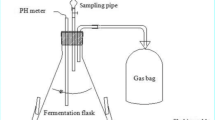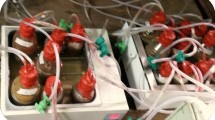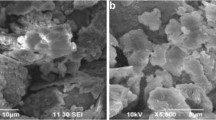Abstract
The coffee pulp is the solid waste most generated during the coffee humid pulping. It contains an elevated concentration of organic matter and lignocellulosic materials. In addition, the low rate of biodegradability of the coffee pulp waste may cause severe environmental damage. Therefore, the aim of this study was to evaluate the effect of acid and thermal pre-treatments in the biodegradability rate, followed by an anaerobic digestion of the coffee pulp and collect biogas production. Thermal and acid pre-treatments (50, 70, and 90 °C, and concentration of 2.5, 5, and 10% V·V−1 of acetic acid, respectively) were applied, both during 1 h, evaluating the organic matter solubilization. Posteriorly, the biodegradability and biogas production using anaerobic digestion for 35 days were evaluated. Finally, during 90 days in semicontinuous, the increase of applied organic load of 1 kg VS m−3 day−1 with Δ 1 kg VS m−3 day−1 every 30 days until reaching 3 kg m−3 day−1 was evaluated. The thermal pretreatment to 90 °C and 1 h improved the solubility and hydrolysis considered limiting of the anaerobic process, reducing the hydraulic retention time from 21 to 15 days, and increasing the biogas yields (0.92 L g VSrem−1 year 79.8% CH4).







Similar content being viewed by others
References
Miñón-Fuentes R, Aguilar-Juárez O (2019) Hydrogen production from coffee pulp by dark fermentation. Water Sci Technol 80(9):1692–1701. https://doi.org/10.2166/wst.2019.416
Chanakya HN, De Alwis AAP (2004) Environmental issues and management in primary coffee processing. Process Saf Environ 82:291–300. https://doi.org/10.1205/095758204323162319
Servicio de Información Agroalimentaria y Pesquera (2016) Anuario Estadístico de la Producción Agrícola. Cierre de la producción agrícola por estado http://infosiap.siap.gob.mx/aagricola_siap_gb/icultivo/index.jsp.
Bonilla-Hermosa VA, Duarte WF, Schwan RF (2014) Utilization of coffee by-products obtained from semi-washed process for production of value-added compounds. Bioresour Technol 166:142–150
Alfaro R, Rodríguez JJ (2009) Nota Técnica Impacto ambiental del procesamiento del café en Costa Rica. Agron Costarric 18(2):217–225 http://www.mag.go.cr/rev_agr/v18n02_217.pdf
Alves RC, Rodríguez F, Nunes MA, Vinha AF, Oliveira MBPP (2017) State of the art in coffee processing by-products. In: Galanakis CM (ed) Handbook of coffee processing by-product. Academic Press, London, pp 1–26
Dessie W, Xin F, Zhang W, Jiang Y, Wu H, Ma J, Jiang M (2018) Opportunities, challenges, and future perspectives of succinic acid production by Actinobacillus succinogenes. Appl Microbiol Biotechnol 102(23):9893–9910
Mahanty B, Zafar M, Han MJ, Park HS (2014) Optimization of codigestion of various industrial sludges for biogas production and sludge treatment: Methane production potential experiments and modelling. Waste Manag 34:1018–1024
Bharathiraja B, Sudharsana T, Jayamuthunagai J, Praveenkumar R, Chozhavendhan S, Iyyappan J (2018) Biogas production: a review on composition, fuel properties, feedstock and principles of anaerobic digestion. Renew Sust Energ Rev 90:570–582
Veluchamy C, Kalamdhad AS (2020) Screening of different thermal heating processes for increased methane production from lignocellulose waste material. Biomass Conv Bioref. https://doi.org/10.1007/s13399-020-00886-9
Corro G, Paniagua L, Pal U, Bañuelos F, Rosas M (2013) Generation of biogas from coffee-pulp and cowdung co-digestion: infrared studies of postcombustion emissions. Energy Convers Manag 7:471–481
Pandey A, Soccol CR, Nigam P, Brand D (2000) Biotechnological potential of coffee pulp and coffee husk for bioprocesses. Biochem Eng J 6:153–162
Rojas JBU, Verreth JAJ, Amato S, Huisman EA (2003) Biological treatments affect the chemical composition of coffee Pulp. Bioresour Technol 89:267–274
Widjaja T, Noviyanto AA, Gunawan S (2016) The effect of rumen and mixed microorganism (rumen and effective microorganism) on biogas production from rice straw waste. ARPN-JEAS 11:2702–2710
Tyagi VK, Lo SL, Rajpal A (2014) Chemically coupled microwave and ultrasonic pre-hydrolysis of pulp and paper mill waste-activated sludge: effect on sludge solubilisation and anaerobic digestion. Environ Sci Pollut Res 21(9):6205–6217
Meyer T, Edwards EA (2014) Anaerobic digestion of pulp and paper mill wastewater and sludge. Water Res 65:321–349
Elliott A, Mahmood T (2012) Comparison of mechanical pretreatment methods for the enhancement of anaerobic digestion of pulp and paper waste activated sludge. Water Environ Res 84(6):497–505
Principi P, König R, Cuomo M (2019) Anaerobic digestion of lignocellulosic substrates: benefits of pre-treatments. Curr Sustain/Renew Energy Rep 6(3):61–70
Kim M, Kim B-C, Nam K, Choi Y (2018) Effect of pretreatment solutions and conditions on decomposition and anaerobic digestion of lignocellulosic biomass in rice straw. Biochem Eng J 140:108–114
Tyagi VK, Lo SL (2011) Application of physico-chemical pretreatment methods to enhance the sludge disintegration and subsequent anaerobic digestion: an up to date review. Rev Environ Sci Biotechnol 10:215–242. https://doi.org/10.1007/s11157-011-9244-9
Atenodoro-Alonso J, Ruíz-Espinoza JE, Alvarado-Lassman A, Martínez-Sibaja A, Martínez-Delgadillo SA, Méndez-Contreras JM (2015) The enhanced anaerobic degradability and kinetic parameters of pathogenic inactivation of wastewater sludge using pre-and post-thermal treatments Part 2. Rev Mexicana Ingeniería Quím 14(2):311–319
Menert A, Vaalu T, Michelis M, Blonskaja V, Rikmanasn E, Mets A, Vilu R (2008) Influence of thermal pre-treatment on mesophilic anaerobic digestion of sludges. Proceedings of the 7th International Conference. Environmental Engineering, Faculty of Environmental Engineering, Vilnius Gediminas Technical University, May 22–23, 2008, Vilnius, Lithuania, 625–635.
Wilson CA, Novak J (2009) Hydrolysis of macromolecular components of primary and secondary wastewater sludge by thermal hydrolytic pre-treatment. Water Res 43:4489–4498
Yang X, Wang X, Wang L (2010) Transferring of components and energy output in industrial sewage sludge disposal by thermal pretreatment and two-phase anaerobic process. Bioresour Technol 101(8):2580–2584
Monlau F, Barakat A, Steyer JP, Carrere H (2012) Comparison of seven types of thermo-chemical pretreatments on the structural features and anaerobic digestion of sunflower stalks. Bioresour Technol 120:241–247
Paul S, Dutta A (2018) Challenges and opportunities of lignocellulosic biomass for anaerobic digestion. Resour Conserv Recycl 30:164–174
Kim JS, Lee YY, Kim TH (2016) A review on alkaline pretreatment technology for bioconversion of lignocellulosic biomass. Bioresour Technol 199:42–48
Corrêa CLO, Penha EM, Freitas-Silva O, Luna AS, Gottschalk LMF (2020) Enzymatic technology application on coffee co-products: A review. Waste Biomass Valor. https://doi.org/10.1007/s12649-020-01208-w
Procentese A, Raganati F, Navarini L, Olivieri G, Russo ME, Marzoccchella A (2018) Coffee silverskin as a renewable resource to produce butanol and isopropanol. Chem Eng Trans 64:139–144
Hijosa-Valsero M, Garita-Cambronero J, Paniagua-García AI, Díez-Antolínez R (2018) Biobutanol production from coffee silverskin. Microb Cell Factories 17(1):1–9
Pleissner D, Neu AK, Mehlmann K, Schneider R, Puerta-Quintero GI, Venus J (2016) Fermentative lactic acid production from coffee pulp hydrolysate using Bacillus coagulans at laboratory and pilot scales. Bioresour Technol 218:167–173
Dos Santos LC, Adarme OFH, Baêta BEL, Gurgel LVA, De Aquino SF (2018) Production of biogas (methane and hydrogen) from anaerobic digestion of hemicellulosic hydrolysate generated in the oxidative pretreatment of coffee husks. Bioresour Technol 263:601–612
Chala B, Oechsner H, Latif S, Müller J (2018) Biogas potential of coffee processing waste in Ethiopia. Sustainability 10(8):2678
Moreno EL, Zapata AD (2019) Biohydrogen production by co-digestion of fruits and vegetable waste and coffee mucilage. Rev Facult Nacional Agronomía Medellín 72(3):9007–9018
Ruiz-Espinoza JE, Méndez-Contreras JM, Alvarado-Lassman A, Martínez-Delgadillo SA (2012) Effect of low temperature thermal pre-treatment on the solubilization of organic matter, pathogen inactivation and mesophilic anaerobic digestion of poultry sludge. J Environ Sci Health A 47(12):1795–1802
Nava-Valente N, Alvarado-Lassman A, Nativitas-Sandoval LS, Méndez-Contreras JM (2016) Improved anaerobic digestion of a thermally pretreated mixture of physicochemical sludge; broiler excreta and sugar cane wastes (SCW): effect on organic matter solubilization, biodegradability and bioenergy production. J Environ Sci Health A 51(5):446–453
Liao X, Li H, Zhang Y, Liu C, Chen Q (2016) Accelerated high-solid anaerobic digestion of sewage sludge using low-temperature thermal pretreatment. Int Biodeterior Biodegrad 106:141–149
Rodriguez C, Alaswad A, Benyounis KY, Olabi AG (2017) Pretreatment techniques used in biogas production from grass. Renew Sust Energ Rev 68(Part 2):1193–1204
Taherzadeh MJ, Karimi K (2008) Pretreatment of lignocellulosic wastes to improve ethanol and biogas production: a review. Int J Mol Sci 9(9):1621–1651
Gonzalez R, Jameel H, Chang H, Treasure T, Pirraglia A, Saloni D (2011) Thermo-mechanical pulping as a pretreatment for agricultural biomass for biochemical conversion. Bioresources. 6(2):1599–1614
Lizama AC, Figueiras CC, Herrera RR, Pedreguera AZ, Espinoza JER (2017) Effects of ultrasonic pretreatment on the solubilization and kinetic study of biogas production from anaerobic digestion of waste activated sludge. Int Biodeterior Biodegradation 123:1–9
López-Escobar LA, Martínez-Hernández S, Corte-Cano G, Méndez-Contreras JM (2014) Influence of organic loading rate on methane production in a CSTR from physicochemical sludge generated in a poultry slaughterhouse. J Environ Sci Health A 49(14):1710–1717
APHA (2005) Standard methods for the examination of water and wastewater. American Public Health Association (APHA), Washington
Gerhard P, Murray RGE, Wood WA, Krieg NR (1994) Methods for general and molecular bacteriology. ASM Press, Washington, DC
Battista F, Fino D, Mancini G (2016) Optimization of biogas production from coffee production waste. Bioresour Technol 200:884–890
Metcalf L, Eddy HP, Tchobanoglous G (1991) Wastewater engineering: treatment, disposal, and reuse (Vol. 4). McGraw-Hill, New York
Fan J, Wang W, Zhang B, Guo Y, Ngo HH, Guo W, Zhang J, Wu H (2013) Nitrogen removal in intermittently aerated vertical Flow constructed wetlands: impact of influent COD/N ratios. Bioresour Technol 143:461–466
Haddis A, Devi R (2008) Effect of effluent generated from coffee processing plant on the water bodies and human health in its vicinity. J Hazard Mater 152(1):259–262
Cruz-Salomón A, Ríos-Valdovinos E, Pola-Albores F, Lagunas-Rivera S, Meza-Gordillo R, Ruíz-Valdiviezo VM (2018) Evaluation of hydraulic retention time on treatment of coffee processing wastewater (CPWW) in EGSB bioreactor. Sustainability 10(1):83
Appels L, Degreve J, Van der Bruggen B, Van Impe J, Dewil R (2010) Influence of low temperature thermal pretreatment on sludge solubilization, heavy metal release and anaerobic digestion. Bioresour Technol 101:5743–5748
Liu Y, Li X, Kang X, Yuan Y, Jiao M, Zhan J, Du M (2015) Effect of extracelular polymeric substances disintegration by ultrasonic pretreatment on waste activated sludge acidification. Int Biodeterior Biodegrad 102:31–136
Zhang J, Lv C, Tong J, Liu J, Liu J, Yu D, Wang Y, Chen M, Wei Y (2015) Optimization and microbial community analysis of anaerobic co-digestion of food waste and sewage sludge based on microwave pretreatment. Bioresour Technol 200:253–261
Wu L, Higashimori A, Qin Y, Hojo T, Kubota K, Li Y (2016) Comparison oh hyper thermophilic-mesophilic two-stage with single-stage mesophilic anaerobic digestion of waste activated sludge: process performance and microbial community analysis. Chem Eng J 290:290–301
Frijns J, Hofman J, Nederlof M (2013) The potential of (waste) water as energy carrier. Energy Convers Manag 65:357–363
Kor-Bicakci G, Eskicioglu C (2019) Recent developments on thermal municipal sludge pretreatment technologies for enhanced anaerobic digestion. Renew Sust Energ Rev 110:423–443
Devlin DC, Esteves SRR, Dinsdale RM, Guwy AJ (2011) The effect of acid pretreatment on the anaerobic digestion and dewatering of waste activated sludge. Bioresour Technol 102(5):4076–4082
Pavlostathis SG, Gossett JM (1986) A kinetic model for anaerobic digestion of biological sludge. Biotechnol Bioeng 28(10):1519–1530
Appels L, Baeyens J, Degrève J, Dewil R (2008) Principles and potential of the anaerobic digestion of waste-activated sludge. Prog Energy Combust Sci 34(6):755–781
Weemaes MP, Verstraete WH (1998) Evaluation of current wet sludge disintegration techniques. J Chem Technol Biotechnol: Int Res Process, Environ Clean Technol 73(2):83–92
Vismara R, Canziani R, Malpei F, Piccinini S (2011) Biogas da agrozootecnia e agroindustria. Dario Flaccovio Editore, Palermo
Anjum NA, Sharma P, Gill SS, Hasanuzzaman M, Khan EA, Kachhap K, Sofo A (2016) Catalase and ascorbate peroxidase—representative H2O2-detoxifying heme enzymes in plants. Environ Sci Pollut Res 23(19):19002–19029
Pilli S, Bhunia P, Yan S, LeBlanc RJ, Tyagi RD, Surampalli RY (2011) Ultrasonic pretreatment of sludge: a review. Ultrason Sonochem 18(1):1–18
Zhen G, Lu X, Kato H, Zhao Y, Li Y (2017) Overview of pretreatments strategies for enhancing sewage sludge disintegration and subsequent anaerobic digestion: current advances, full-scale applications and future perspectives. Renew Sust Energ Rev 69:559–577
Sophie M, Li Q, Takayanagi K, Li YY (2015) Comprehensive monitoring and management of a long-term thermophilic CSTR treating coffee grounds, coffee liquid, milk waste, and municipal sludge. Bioresour Technol 192:202–211
Li Q, Li YY, Quiao W, Wang X, Tagayanagi K (2015a) Sulfate addition as an effective method to improve methane fermentation performance and propionate degradation in thermophilic anaerobic co-digestion of coffee grounds, milk and waste activated sludge with AnMBR. Bioresour Technol 185:308–315
Corro G, Paniagua L, Pal U, Bañuelos F, Rosas M (2013) Generation of biogas from coffee-pulp and cow-dung co-digestion: infrared studies of postcombustion emissions. Energy Convers Manag 74:471–481
Jard G, Jackowiak D, Carrère H, Delgenès JP, Torrijos M, Steyer JP, Dumas C (2012) Batch and semi-continuous anaerobic digestion of Palmaria palmata: comparison with Saccharina latissima and inhibition studies. Chem Eng J 209:513–519
Baier U, Schleiss K (2005) Greenhouse gas emission reduction through anaerobic digestion of coffee pulp. In Proceedings of the 4th International Symposium Anaerobic Digestion of Solid Waste, Copenhagen, Denmark (Vol. 31)
Savoo S, Mudhoo A (2018) Biomethanation macrodynamics of vegetable residues pretreated by low-frequency microwave irradiation. Bioresour Technol 248:280–286
Murthy PS, Naidu MM (2012) Sustainable management of coffee industry by-products and value addition—a review. Resour Conserv Recycl 66:45–58
Code availability
Not applicable
Funding
This study was partially funded by the “Tecnológico Nacional de México” with their “Convocatoria 2020: Proyecto de Investigación Científica.”
Author information
Authors and Affiliations
Contributions
All authors contributed to the study conception and design. Material preparation, data collection, and analysis were performed by Noemi Nava-Valente, Oscar Andrés Del Ángel Coronel, Jesús Atenodoro-Alonso, and Luis Antonio López Escobar. The first draft of the manuscript was written by Noemi Nava-Valente, and all authors commented on previous versions of the manuscript. All authors read and approved the final manuscript.
Corresponding author
Ethics declarations
Ethics approval
Not applicable.
Consent to participate
Not applicable.
Consent for publication
All authors read the manuscript and expressed their consent for publication.
Competing interests
The authors declare no competing interests.
Additional information
Publisher’s Note
Springer Nature remains neutral with regard to jurisdictional claims in published maps and institutional affiliations.
Rights and permissions
About this article
Cite this article
Nava-Valente, N., Del Ángel-Coronel, O.A., Atenodoro-Alonso, J. et al. Effect of thermal and acid pre-treatment on increasing organic loading rate of anaerobic digestion of coffee pulp for biogas production. Biomass Conv. Bioref. 13, 4817–4830 (2023). https://doi.org/10.1007/s13399-021-01529-3
Received:
Revised:
Accepted:
Published:
Issue Date:
DOI: https://doi.org/10.1007/s13399-021-01529-3




